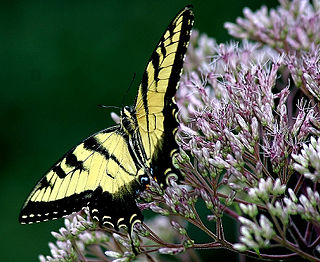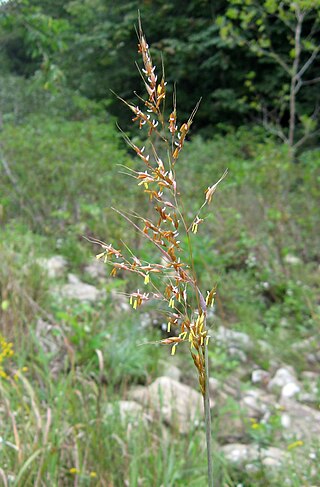
Eutrochium fistulosum, also called hollow Joe-Pye weed, trumpetweed, or purple thoroughwort, is a perennial North American flowering plant in the family Asteraceae. It is native to southern Canada and throughout the eastern and south central United States from Maine west to Ontario, Wisconsin, and Missouri and south as far as Florida and Texas. The specific name fistulosum refers to the tubular stem; see fistula.

Oenothera is a genus of about 145 species of herbaceous flowering plants native to the Americas. It is the type genus of the family Onagraceae. Common names include evening primrose, suncups, and sundrops. They are not closely related to the true primroses.

Oenothera biennis, the common evening-primrose, is a species of flowering plant in the family Onagraceae, native to eastern and central North America, from Newfoundland west to Alberta, southeast to Florida, and southwest to Texas, and widely naturalized elsewhere in temperate and subtropical regions. Evening primrose oil is produced from the plant.

Manduca quinquemaculata, the five-spotted hawkmoth, is a brown and gray hawk moth of the family Sphingidae. The caterpillar, often referred to as the tomato hornworm, can be a major pest in gardens; they get their name from a dark projection on their posterior end and their use of tomatoes as host plants. Tomato hornworms are closely related to the tobacco hornworm Manduca sexta. This confusion arises because caterpillars of both species have similar morphologies and feed on the foliage of various plants from the family Solanaceae, so either species can be found on tobacco or tomato leaves. Because of this, the plant on which the caterpillar is found does not indicate its species.

Eryngium yuccifolium, known as rattlesnake master, button eryngo, and button snake-root, is a perennial herb of the parsley family native to the tallgrass prairies of central and eastern North America. It grows from Minnesota east to Ohio and south to Texas and Florida, including a few spots in Connecticut, New Jersey, Maryland, and Delaware.

Sorghastrum nutans, commonly known as either Indiangrass or yellow Indiangrass, is a North American prairie grass found in the Central United States, the Eastern United States, and Canada, especially in the Great Plains and tallgrass prairies.

Deschampsia cespitosa, commonly known as tufted hairgrass or tussock grass, is a perennial tufted plant in the grass family Poaceae. Distribution of this species is widespread including the eastern and western coasts of North America, parts of South America, Eurasia and Australia.

Hibiscus moscheutos, the rose mallow, swamp rose-mallow, crimsoneyed rosemallow, or eastern rosemallow, is a species of flowering plant in the family Malvaceae. It is a cold-hardy perennial wetland plant that can grow in large colonies. The hirsute leaves are of variable morphology, but are commonly deltoidal in shape with up to three lobes. It is found in wetlands and along the riverine systems of the eastern United States from Texas to the Atlantic states, its territory extending northward to southern Ontario.

Asclepias asperula, commonly called antelope horns milkweed or spider milkweed, is a species of milkweed native to the Southwestern United States and northern Mexico.

Liatris pycnostachya, the prairie blazing star, cattail gayfeather or cattail blazing star, is a perennial plant in the Asteraceae family that is native to the tallgrass prairies of the central United States.

Phlox pilosa, the downy phlox or prairie phlox, is an herbaceous plant in the family Polemoniaceae. It is native to eastern North America, where it is found in open areas such as prairies and woodlands.

Potentilla gracilis, known as slender cinquefoil or graceful cinquefoil, is a species of cinquefoil. It ranges from Alaska down the west coast of Canada and the United States, and Colorado.

Elymus glaucus is a species of grass known as blue wild rye or blue wildrye. This grass is native to North America from Alaska to New York to northern Mexico. It is a common and widespread species of wild rye.

Festuca idahoensis is a species of grass known by the common names Idaho fescue and blue bunchgrass. It is native to western North America, where it is widespread and common. It can be found in many ecosystems, from shady forests to open plains grasslands.

Senna marilandica, commonly known as Maryland senna, Maryland wild senna, and wild senna, is a perennial flowering plant in the pea family (Fabaceae) native to the United States. It blooms in the summer with yellow flowers, followed by long seed pods, and can grow up to 2 m (6 ft) tall. It prefers average to wet soil.

Dalea candida is a species of flowering plant in the legume family known by the common name white prairie clover. It is native to North America, where it can be found throughout central Canada, the central United States, and northern Mexico. It can sometimes be found outside its range as an introduced species. It grows in many types of habitat, including several types of prairie, foothills, woods, forests, and disturbed areas.

Lespedeza capitata is a species of flowering plant in the Fabaceae, or legume family, and is known by the common name roundhead bushclover, or roundhead lespedeza. It is native to eastern North America, including eastern Canada and the eastern half of the United States.

Liatris ligulistylis is a flowering plant of the family Asteraceae, native to the central United States and central Canada.

Verbesina alternifolia is a species of flowering plant in the family Asteraceae. It is commonly known as wingstem or yellow ironweed. It is native to North America.

A pollinator garden is a type of garden designed with the intent of growing specific nectar and pollen-producing plants, in a way that attracts pollinating insects known as pollinators. Pollinators aid in the production of one out of every three bites of food consumed by humans, and pollinator gardens are a way to offer support for these species. In order for a garden to be considered a pollinator garden, it should provide various nectar producing flowers, shelter or shelter-providing plants for pollinators, and avoid the use of pesticides.





















